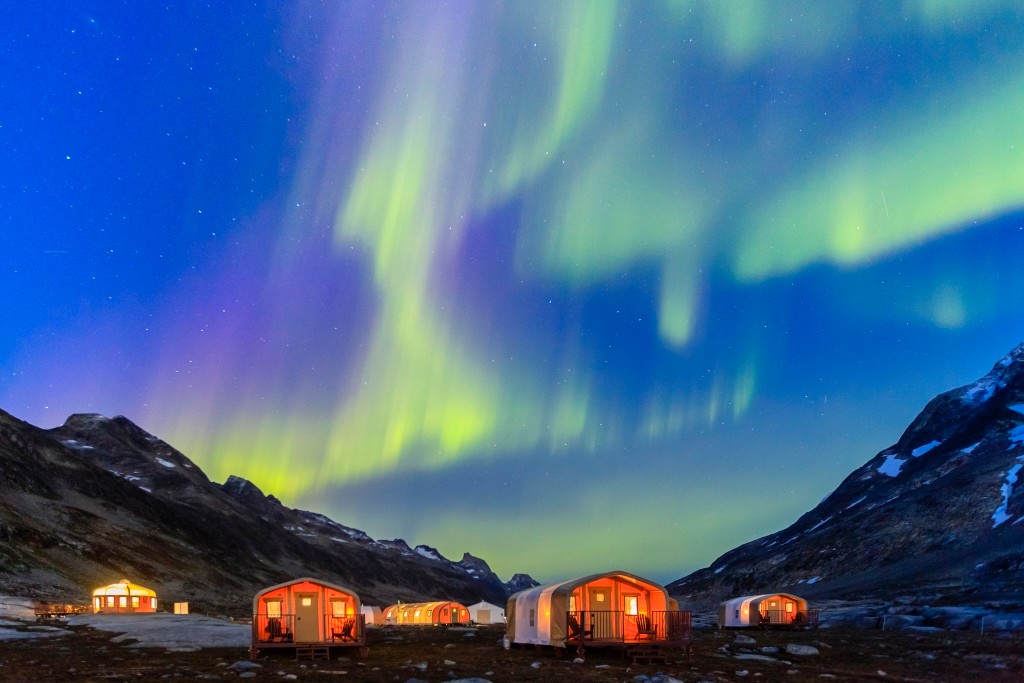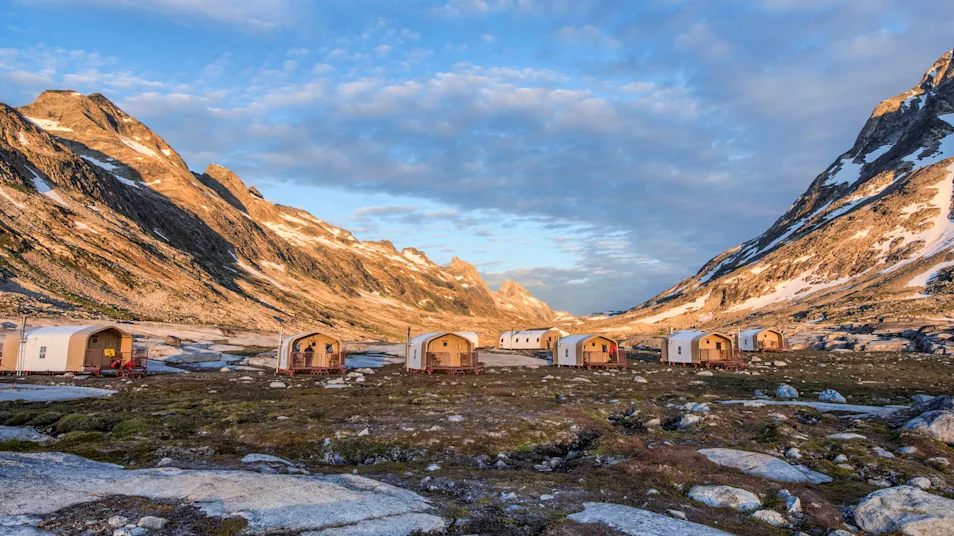
Know Before You Go


The Genesis of an East Greenland Safari Camp
By Ben Bressler, Founder and President of Natural Habitat Adventures

© Olaf Malver
Olaf Malver is exactly who you’d imagine when you think of a classic explorer. With a large square head atop a 6-foot 3-inch frame, he is imposing. His deep Scandinavian growl reveals itself when he becomes animated, reminding me to keep my place. He is kind-hearted and tough as granite, all at once.
Born to a Norwegian father and a Swedish mother, Olaf was raised in Denmark, educated in the United States, and has traveled the high Arctic in a kayak and the Antarctic Peninsula in a small sailboat. He has accomplished more in a lifetime than I could in 1,000 years.
Olaf is the adventurer I’d like to think I am. But I am not.
There are brains behind Olaf’s brawn, of course. He earned both a Ph.D. in chemistry in Denmark and an international law and diplomacy degree from Tufts University. These paths led first to fundamental research in bio-organic chemistry at University of California San Francisco, then a career stop at the World Bank, where he worked at the intersection of economic development and conservation. But along the way he also spent six months on a submarine in the Danish Navy, and learned to speak six languages. He has climbed first ascents all over the world and was the first person to kayak around the perimeter of South Georgia Island in the Southern Ocean. (Yeah, that’s the same South Georgia where Shackleton landed.) And, just to top it off, Olaf is a master winemaker with his own vineyard and winery in the Republic of Georgia—widely recognized as the birthplace of wine.
In 2010, Natural Habitat Adventures purchased Olaf’s small expedition travel company, Explorers’ Corner, named after the corner of classic libraries where serious adventurers studied ancient dusty maps in preparation for journeys where most dared not go. I hoped that by adding Olaf’s collection of highly-planned, thoughtful expeditions in areas only accessible by human power—by foot or kayak—we could include more authentic and active adventures to our offerings of worldwide nature journeys. What I did not anticipate was that Olaf and I would become close friends.
Once a year, Olaf pays a visit to Boulder—ostensibly to work, but, truthfully, his role is mostly that of inspirer. Our staff is made up of a nice blend of highly experienced travel professionals and newer-to-the-workforce adventure enthusiasts. Everyone becomes wide-eyed when Olaf holds court. Adventure travel is about stories, and Olaf’s stories are epic.
I particularly enjoy hearing the one about when the government of Madagascar required him to chaperone a prisoner during his two-week kayak trip down a previously unnavigated river. And the one where the Pentagon flew him to Washington to consult on the topography of Georgia. Every year, I hear new tales.

© Sara Higgins
During a summer evening on one such visit, the seeds of Base Camp Greenland were sewn. We were sitting in Adirondack chairs on my flagstone patio in the shadow of Boulder’s Flatirons, drinking Scotch that Olaf insists he bought in Scotland, but I know he purchased at the airport on the way to Colorado. It’s an annual liars’ dance we do together.
Olaf turned the conversation to Greenland, his ultimate passion. At this point, Olaf had led 25 expeditions to Greenland, and he was widely considered a world expert in exploration of the remote eastern coast. Clearly, he loved the place.
“Why can’t we take more guests to Greenland?” he firmly quizzed me. I knew I needed a satisfactory answer fast. He already considered me a bit of a “fake” adventurer because many of my travels included safari trucks or helicopters, rather than just my own muscles.
For years, Olaf had operated an annual 12-day kayaking expedition to East Greenland, sleeping in pup tents and cooking awful camp food with tiny white-gas stoves. His journey was a serious adventure, requiring hardy adventurers to kayak through iceberg-infested waters for 12 hours each day. We couldn’t bring Nat Hab guests on a trip like that. Our travelers are more like me, a Jewish guy from New Jersey. And while my people have done our fair share of wandering, there weren’t many polar bears or icebergs in the desert. Olaf is different. He is a real-life Viking.
We sat for maybe 15 seconds before I thought out loud: “If we could build a luxury camp in Greenland, we’d be golden.” For years, we had been running our Tundra Lodge in the subarctic and our permanent and mobile camps in Africa. We already knew how to do remote luxury. Olaf didn’t pause before proclaiming, “We could do that.” He explained the systems that were being used to run industrial mining camps in the high Arctic and described in detail the specialty tents they used to withstand the northern environs we were imagining. He grabbed a cocktail napkin, and within minutes he’d sketched out a classic safari camp…on the Arctic Circle. Was there anything that eluded this guy?
For the next two days Olaf kept his substantially sized cranium hovered over a computer in his office. He emerged with a long list of items he’d need, each linked to web sources from companies based anywhere from Canada to Denmark. There was a $550,000 budget, too, including options for toilets, water heaters, bed frames, Zodiacs and polar bear safety systems.
Rome may not have been built in a day, but, it seems, a safari camp in Greenland can be planned in just two.

© Sara Higgins
The details started to come together, and it was time to choose the location for our camp. Olaf doesn’t adventure half-assed, so Greenland’s remote east coast was the obvious choice over the more populated west coast. Olaf and I, along with my 15-year old son and a few others from the office, flew to Reykjavik, then onto Kulusuk, where we jumped on a helicopter to Tasiilaq, Greenland’s main east coast “city”–population about 2,000. There, we planned and researched for a few days before boating northward to a spot that Olaf knew along the 800-mile Sermilik Fjord that shoulders the Greenland ice sheet. We camped on a wide rocky shoreline at the end of a valley stream, and headed out by small boat and kayak to explore possible camp locations.
There were quite a few factors we needed to consider when choosing the perfect location—easy boat access, shelter from the wind and, most importantly, a source of fresh water. Glacial meltwater contains silt and sand, making it unsafe for consumption. If you drink it, you’ll get diarrhea. Yuck.
After a week of exploration, we realized that the location where we were camped was indeed the perfect spot. Olaf had quietly suggested this at the start, but he knew we needed to explore and come to this conclusion for ourselves: Vikings should always go with their gut.
In Greenland, land ownership is a very different concept than what we know in North America and Europe. To “own” land you simply show up in the land office with GPS coordinates and hand them over. The land becomes yours. Simple. And, as long as you visit your land every two years, it remains yours. If you don’t, someone else can claim it. Odd perhaps, but somehow in a country this vast and empty, it makes sense.

© Sara Higgins
With the camp location settled, we waited for our gear to arrive. Two tons of stuff, from kitchen towels to back-up generators, shipped from dozens of sources worldwide, appeared in the tiny hamlet of Tinit, a village of just 100 inhabitants that lies across the bay from our site. Before getting to Tinit, however, the gear had to be carried in large merchant ships to Tasiilaq, where it was transferred to smaller boats for the journey up the fjord. In Tinit, the cargo was passed up the pier by hand, then watched over by locals as it sat stored in shipping containers through the winter. Once summer melted the frozen bay, we sent the gear on its final journey by Zodiac across the water to our camp.
Because of the short summer season, our plan was to build the camp, make sure everything was laid out just the way we needed it, then break it all down and pile it into an on-site storage shed for the winter. Of course, we had to build the storage shed first. And the entire camp was built on rock, so this was not easy to accomplish with a hand drill. We sent a team of experts and engineers to drill pilons into the stone, and we hired plenty of locals to perform the work.
Summer normally begins in early July, and winter rolls in around late September, so we had about eight to 10 weeks to lay out and construct the camp. As soon as it was complete, we took it apart to store it and wait another year to rebuild for our first guests to arrive. It was three years from conception to completion, and this bold idea hatched over a Scotch on my porch was indeed coming to fruition.
That winter after our initial construction gave us a kick in the teeth: It turned out to be East Greenland’s snowiest in 100 years. When our staff arrived in the spring to set up for our inaugural season, 10 feet of snow and ice had buried the storage shed. Only the roof peaked through. What a fitting start to Nat Hab’s most adventurous endeavor yet.
Olaf, a team of locals and a few Boulder-based Nat Habbers set off with snow shovels to uncover the storage shed so we could remove our gear. Then they shoveled the rest of the camp area, hundreds of square yards of rolling terrain that took a special kind of tenacity to clear.
The locals thought we were crazy from the start. Why would anyone try to build a luxury camp in an area this remote? At this point, I can’t say I disagreed with them. But we were committed to making it happen, and after a week of shoveling, we were able to build the camp.
Finally, all that was left to install was the kitchen’s industrial stove. It was just arriving from Europe, so we had to bring it in by dog sled. Unfortunately, once it got to camp, we realized our gas line to the kitchen was designed in U.S. measurements, while our stove was designed to European standards. It would not connect. We didn’t have a stove, and our guests, who I assumed would want to eat during their stay, were arriving in just days.
Now having worked together for several years, the locals had started to come around and were beginning to see the benefit of our facility being a part of their community. There was economic incentive to work together, and, just as important, we were becoming friends. When Olaf headed to Tinit to ask around, we lucky enough to be able to secure a home kitchen stove that would work with our gas line. It wasn’t the industrial stove we had originally wanted, but it worked. Perfectly. A little improvisation goes a long way in Greenland.

© Ralph Lee Hopkins
With just a day to spare, our first guests arrived, and Base Camp Greenland had become a reality. During all my years in adventure travel, it took a very bold idea—and $1.4 million dollars versus the planned $550,000—to learn that in a place like Greenland, or any seriously remote locale, you need friends. Greenlandic friends like the locals who steward this grand landscape at the base of the ice sheet, and who graciously share it with us…and friends like Olaf, who teaches me daily that anything is possible.
































